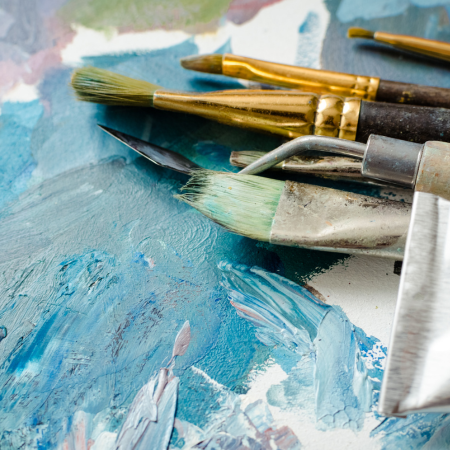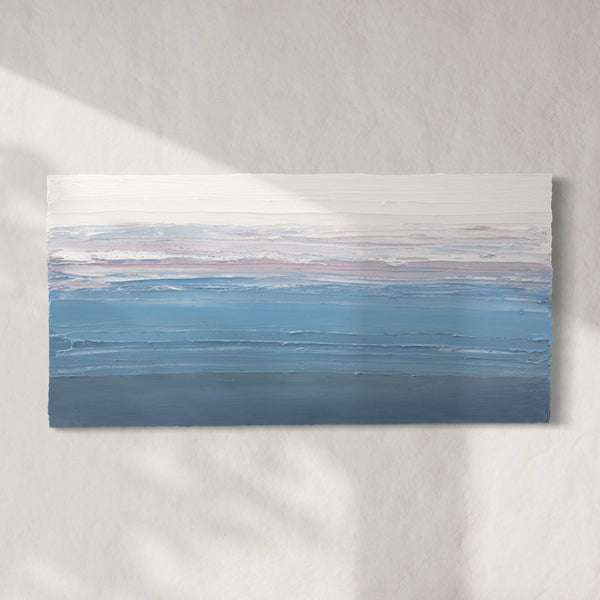Whether you're exploring paintings to add to your growing art collection or just trying to learn more about art in general, you may be wondering about the differing types of paint media you see on labels in museums, galleries, and websites. To help clarify, we've compiled a list of the primary types of paint you might see listed next to modern and historical paintings. Read the types to learn more about their history, and what the medium means for the painting you might be thinking of purchasing.
Oil Paint
Oil paint is made with finely-crushed pigments and drying seed or vegetable oils - most commonly linseed. The medium is believed to have been used throughout history, but became widely used during the Northern and Italian Renaissance periods. Oil paint dries very slowly, which means that artists can mix paints directly on the canvas, and must wait periods of time for layers to dry before moving on to the next phase in their painting process. A completed oil painting can take years to thoroughly dry, depending on how thickly the layers of paint have been applied, creating a progressively harder finish as time goes on.
What It Means:
Paintings made with oil paint take a longer time to dry, and therefore complete, than most other paint media. Artists may also work more intuitively as they blend colors directly on the canvas, which can result in a painterly finish. Oil paints can be quite expensive due to their makeup in comparison to other types of paints, as well, so the quality of oil paint may factor into higher price points for oil paintings. While oil paint is understood to be relatively durable, if it is improperly applied, cracking may form over several decades.
Acrylic Paint
Acrylic paint is a more recent development in the paint world as compared to oil paint. Acrylic paint is a water-based paint so it dries much faster than oils, and uses water as a thinning agent while oils require turpentine or alternative paint thinners. As a result, artists can work faster and the materials pose less risk (to breathe and touch). Moreover, mistakes or necessary changes must be covered with a new layer of paint rather than corrected directly on canvas the way they might be with oil paints.
What It Means:
Acrylic paint can be equally as vibrant as oils. However, artists are able to work faster, and even have direct contact with the paint due to its non-toxic nature. Because acrylic is essentially a plastic coating over the canvas, it has an excellent longevity and will not necessarily face the same exposure hazards as oil paint, like yellowing or cracking. And while it's never recommended to hang acrylic paintings in direct sunlight, they typically hold up to natural elements in ways that other paints might not.
Watercolor Paint
Watercolor paint combines finely-ground color pigments mixed with a water-soluble binding substance (this usually consists of gum, glucose, glycerine, and wetting agents - per Tate Modern's glossary). Watercolor paint is usually painted on specific paper rather than canvas or board, and has a semi-transparent quality and fast drying time. Watercolor paper may need to be stretched, which involves completely wetting the paper and then drying it prior to painting in order to prevent unwanted wrinkling. The medium is sometimes viewed as being difficult to control, but varying techniques allow the paint to be more or less managed, as needed.
What It Means:
It can take significant practice to learn how to manipulate watercolor paint. Watercolor paintings are often done in layers, similarly to acrylic and oil paintings, and have quick drying times like acrylics. Understanding the associated techniques may take trial and error, but yields a lovely, washy finish. These paintings are susceptible to fading so should not be hung in direct sunlight, and should generally be framed in UV protected frames to ensure the longevity of the piece.
Gouache
Gouache is a type of watercolor paint. It is largely made of the same components as standard watercolor, but the ratio of ingredients is altered and white paint is added, resulting in a water-soluble paint that is fully opaque. Conversely to watercolor, gouache can be reactivated with water; so while it dries quickly, it can also be re-worked even after it's been applied.
What It Means:
Acrylic paint dries and must be painted over to make adjustments or fix mistakes, and watercolor is largely understood to be one of the most unforgiving of paint media. Gouache has a creamier consistency, like that of an acrylic, and is more versatile than watercolor and acrylic due to the fact that it can be re-activated, so changes can be made after the fact - without having to bide by the slow timeline of oils. Gouache can also safely be used in conjunction with acrylic paints, making it an even more versatile option for artists, particularly beginners.
Tempera
Tempera paint is an old medium that has been used by artists for centuries. Similar to watercolor and gouache, tempera paint includes color pigments that are bound to a water-soluble substance. The substance, though, varies in that it historically was made of egg and water or egg and oil. Now, more modern tempera paints use alternatives like starch or gum-water as substitute. Tempera is not typically applied to canvas, and should be used on more rigid and porous surfaces like paper or wood panel.
What It Means:
Tempera paint is slightly less common than the other paint media discussed here. It is not considered the most durable paint, as it can crack over time. It does have a quick drying time and can be reactivated, though, so it is similar to gouache in that it can be re-worked after being applied.
Encaustic
Encaustic means to “burn in” from the Greek word "enkaustikos." This name comes from the fact that in encaustic painting, each layer must be fused with heat to the layer beneath it. The base medium is primarily made from beeswax. The wax is mixed with damar resin, which is crystallized sap from fir trees. The damar resin provides hardness while the wax provides luminosity. Encaustic art can be made with only this clear combination, or mixed with high quality pigments.
What It Means:
Encaustic paint is applied in layers and requires various tools that typical paint does not. This means it can be a more laborious process than a regular painting on canvas. Encaustic paintings are very durable, and due to the use of pigment with natural substances like beeswax or damar resin, it is a very sustainable painting practice that incorporates renewable resources.
Spray Paint
Spray paint is a type of paint which is sprayed from an aerosol can directly onto the painting surface, rather than being applied with a brush or palette knife. Spray paints can be oil or water-based. Most often associated with outdoor painting, like graffiti or commissioned mural art, many artists have begun to incorporate spray paint into more traditional painting on canvas or board. Spray paint fills in canvas textures very effectively, and it can be mixed with other paint types as long as the base component matches (i.e. water-based paint, like acrylic, can be mixed with water-based spray paint). Spray paint is highly durable and long-lasting, but should always be used outside or in very well-ventilated areas.
What It Means:
Spray paint is versatile and its use on canvas or board may signal a more experimental artist who may be comfortable trying new media into their work. Spray paint is quick drying and long-lasting.
You can find definitions of these paint types and more general art terms in our Glossary of Art Terms. Or, contact us with specific questions about a medium you see listed on Sorelle Gallery's website.




1 comment
Post a comment
Alexander Grape
Very good thank you for telling me about the different types of paints. :D